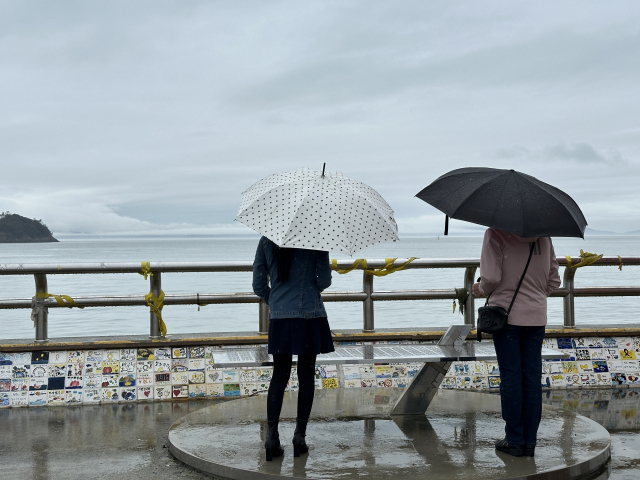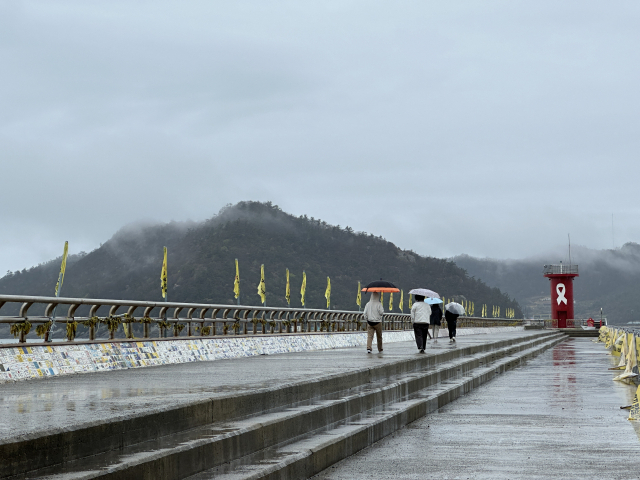[From the Scene] Search for truth about Sewol ferry disaster continues
In two places struck by unprecedented tragedy 10 years ago, people grieve for victims, yearn for truth, safer society
By Lee Jaeeun, Lee Jung-jooPublished : April 15, 2024 - 15:44

ANSAN, Gyeonggi Province/JINDO, South Jeolla Province -- Time appears to stand still in a classroom in Ansan, Gyeonggi Province.
The classroom is one of several replica classrooms built in memory of the students and teachers of Danwon High School who lost their lives on a school trip to Jeju Island on April 16, 2014, aboard the Sewol ferry. It is filled with the desks, chairs, blackboards, windows and doors used by the teachers and students before the ferry sank off Jindo in South Jeolla Province.
Notes reading, "Let's study hard to enter universities in Seoul," or a calendar with April 16 marked as "Jeju Island field trip!" are still attached to the walls. The classroom looks as if it will soon be filled with students, but the room remains empty, its atmosphere solemn.

Ten years ago, 325 Danwon High School students and 14 teachers were among the 476 passengers onboard the Sewol ferry that day. Only 172 survived the sinking, including only 75 Danwon students.
“As the 10th anniversary of the tragedy approaches, I decided to come visit,” a woman in her 30s surnamed Kim said at the memorial classrooms on March 28.
"I cried a lot as I looked around the classrooms. Sadly, all of the victims were students who each had dreams and hopes. I will always remember this tragedy.”
Kim is one of many who live in Ansan and Jindo who each year remember the tragedy and the young lives lost.
In Ansan and Jindo, cars bore stickers with the words "April 16. I will remember that day," while yellow ribbons adorned bags and phones as tributes to the tragedy.

Choi Sun-hwa, who introduced herself as the mother of Lee Chang-hyun, a sophomore at Danwon High School who perished in the tragedy, said that she knows much of the Korean public still remembers the disaster in their hearts.
From Feb. 25 to March 16, the bereaved families, including Choi, and other citizens walked together as a part of the “National Citizen March for Truth, Responsibility, Life, and Safety” to commemorate the 10th anniversary of the incident.
Participants marched without missing a day during the 21-day walk from Jeju Island to Seoul. “We have confirmed that many citizens have understood (us). We have gained strength from the march over the past three weeks.”

On the same day, dozens of people looked at portraits of the young victims that were set up at a small memorial center at Paengmok Harbor on Jindo.
Visitors to the center said they did not want to let such a tragedy happen again, with some tying yellow ribbons in memory of the victims and others writing letters of condolence and putting them in a sculpture called “Postbox to Heaven,” set up in the middle of the center.
“I knew it was a big accident, but honestly, it didn't hit home that there could have been so many victims. I have a son, and it breaks my heart to think that he could have been a victim of this tragedy,” said Chun Sang-mi, 52. “The bereaved families must have been so sad. In front of the list of victims, I offered my deepest condolences.”

However, the memorial center in Paengmok is struggling to stay open.
"We have repeatedly asked Jindo County to build a proper memorial space, but the county keeps putting it off," said Ryu Hyun-ah, an activist for the 416 Foundation, which was established by the bereaved families of the victims.

10 years on
For the last 10 years, the bereaved families have been fighting for the truth behind the tragedy to be revealed, according to Choi.
“I need to further clarify for the 10th anniversary that the Sewol ferry disaster was not just some common maritime accident, but a disaster which highlighted the problems of Korean society.”
Choi believes the disaster stemmed from a combination of various social problems, including the National Maritime Police's failure to rescue even one student, the presidential office's failure to serve as a disaster control tower, and the state's failure of oversight in protecting the lives of its people. Choi also says this was further exacerbated by political leaders' focus on maintaining power and avoiding taking responsibility for the tragedy.

"The Sewol ferry tragedy shocked and frustrated all Koreans. The pursuit of economic growth prioritized profit over safety, which was exacerbated by neoliberal policies leading to precarious employment and weakened accountability," said Park Chan-goo, an emeritus professor of Ethics Education at Seoul National University.
"Government corruption further undermined oversight in political and social institutions, culminating in this catastrophe. Post-disaster, Korea's societal fabric may be characterized as one of corruption and recurrent accidents."
Faint hope
Many people's lives have changed in the wake of the Sewol ferry disaster. One of those affected by the disaster is Kim Song-mi, who represents an Ansan-based civic group, ONDA, which fights for further investigations into the truth behind the disaster.
“I vividly remember that day. I was working in the administration department at a hospital in Ansan. As I watched repeated news reports on the disaster on television, my thoughts immediately flashed back to my former physical education teacher, Ko Chang-suk.” The late Ko, a teacher at Danwon High School, went missing while trying to rescue his students as the ferry sank.

“After many innocent people died on that day, I became a civic activist seeking social solidarity concerning the Sewol ferry disaster,” said Kim.
“I thought disasters like this were something that happened to others, but after realizing that I was surrounded by the bereaved families of the Sewol ferry tragedy, I thought I should also join them in solidarity. Such disasters can happen to anyone and (they can happen to) me,” said Cha Min-jae, an assistant administrator at the Ansan YMCA.

A decade on, the bereaved families have still not fully uncovered the cause of the disaster or the truth of the circumstances surrounding it, and their questions remain about why the ship sank and why the passengers were not rescued.
Their mission is to build a safer society, and they have repeatedly called on the National Assembly to legislate on the Framework Act on Life Safety.
“I hope that we can prevent future tragedies by making a basic law on life safety so (incidents such as the) Sewol ferry disaster do not happen again,” said Choi.





















![[Today’s K-pop] Treasure to publish magazine for debut anniversary](http://res.heraldm.com/phpwas/restmb_idxmake.php?idx=642&simg=/content/image/2024/07/26/20240726050551_0.jpg&u=)